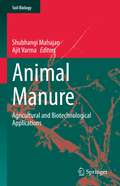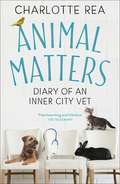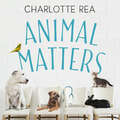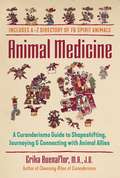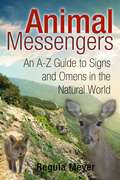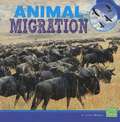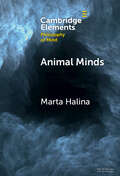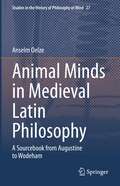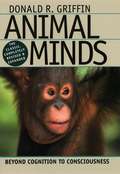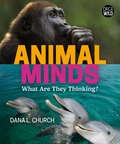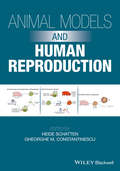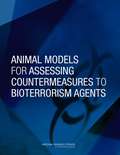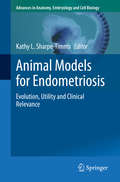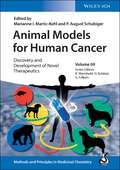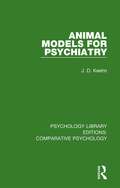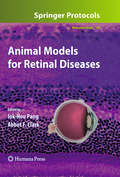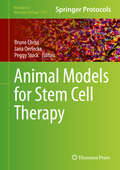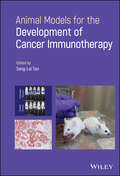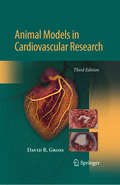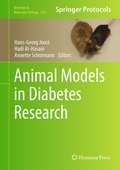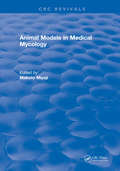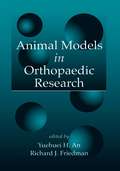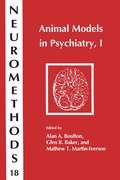- Table View
- List View
Animal Manure: Agricultural and Biotechnological Applications (Soil Biology #64)
by Ajit Varma Shubhangi MahajanThis book covers the basics of animal manure, or animal dung, and highlights its applications in agriculture and biotechnology. The reader is given a comprehensive overview of the different types of animal manure. Although animal manure can cause environmental problems, e.g., when slurry pollutes rivers or burnt dung pollutes air, the book emphasizes the fact that animal dung is by no means a waste product. Animal manure is a valuable organic fertilizer that has a positive impact on soil conditions and helps save on chemical fertilizers. It is also a source of energy and can be either be used as fuel or converted into biogas through methanization. Old-age practices such as the use of dried dung as insulating material, or burnt dung as mosquito repellent are also taken up.With the increasing focus on the UN Sustainable Development Goals (SDGs), this book offers ideas and solutions related to SDG 2 Zero Hunger and SDG 15 Life on Land. The book will not only be an interesting read for students and researchers in the field of agriculture, but will also appeal to scientists working on waste management, organic manure production or in the paper industry.
Animal Matters: Diary of an Inner City Vet
by Charlotte Rea'Heartwarming and hilarious' Telegraph'With as many horrifying stories as heart-warming ones, this is a fascinating look at the year in the life of a vet at a London animal charity hospital. There are some proper belly laughs as well as some insights that will truly stick with you.' - Alexandra Heminsley, GraziaAn unusual 'dalmation', a TV star with cancer, an out of control budgie. Charlotte Rea has seen them all, and more. Animal Matters is Charlotte's diary of real-life cases written during a one year of her work as a veterinary surgeon in a 24-hour inner-city London animal charity. The diary reveals the reality of working as a vet, how it can be both emotional and amusing, one minute you can be consoling an owner on the loss of their much-loved pet, the next trying to catch an escaped budgie. Charlotte mixes deeply sad moments with amusing and unimaginable ones along with more detailed accounts and reflections back on her training and the experiences she has come up against over the decade since she graduated. Throughout the book you will get to know both the animals and the people and how close the bond between us can be. Charlotte also discusses contemporary issues in veterinary medicine such as animal euthanasia, RSPCA welfare cases, mental health issues within the veterinary profession, ethical concerns around pedigree dog breeding and the laws on dangerous dogs. Animal Matters is a moving and heartwarming book about the unconditional love between animals and humans.
Animal Matters: Diary of an Inner City Vet
by Charlotte Rea'Heartwarming and hilarious' TelegraphAn unusual 'dalmation', a TV star with cancer, an out of control budgie. Charlotte Rea has seen them all, and more. Animal Matters is Charlotte's diary of real-life cases written during a one year of her work as a veterinary surgeon in a 24-hour inner-city London animal charity. The diary reveals the reality of working as a vet, how it can be both emotional and amusing, one minute you can be consoling an owner on the loss of their much-loved pet, the next trying to catch an escaped budgie. Charlotte mixes deeply sad moments with amusing and unimaginable ones along with more detailed accounts and reflections back on her training and the experiences she has come up against over the decade since she graduated. Throughout the book you will get to know both the animals and the people and how close the bond between us can be. Charlotte also discusses contemporary issues in veterinary medicine such as animal euthanasia, RSPCA welfare cases, mental health issues within the veterinary profession, ethical concerns around pedigree dog breeding and the laws on dangerous dogs. Animal Matters is a moving and heartwarming book about the unconditional love between animals and humans.
Animal Matters: Diary of an Inner City Vet
by Charlotte ReaAnimals bond people and transcend class, financial and cultural barriers, pets matter to people more than anything, but what happens to those people who can't afford pet insurance or vet's bills.Animal Matters is a diary of real-life cases written during a year of Charlotte's career working as a veterinary surgeon in a 24-hour inner-city London animal charity hospital. The book provides readers with a revealing, honest, emotional experience, with deeply sad moments followed by amusing and unimaginable ones. Charlotte writes both short amusing diary entries along with more detailed accounts and reflections back on her training and the experiences and difficulties she has come up against over the decade since she graduated. Throughout the book you will get to know both the animals and the people and how close the bond between us can be. Charlotte also discusses contemporary issues in veterinary medicine such as animal euthanasia, RSPCA welfare cases, mental health issues within the veterinary profession, ethical concerns around pedigree dog breeding and the laws on dangerous dogs. Animal Matters is a moving and heartwarming book about the unconditional love between animals and humans, and how deep the bond can be.(P)2019 Hodder & Stoughton Limited
Animal Medicine: A Curanderismo Guide to Shapeshifting, Journeying, and Connecting with Animal Allies
by Erika Buenaflor• Includes an alphabetical guide to 76 animals, explaining each animal&’s spiritual gifts, shapeshifting medicine, the realm they are associated with, and their symbolic meaning when they appear in a dream or vision • Details the trance journeying techniques and shapeshifting practices of ancient Mesoamerican shamanic traditions and modern-day curanderismo • Explores how to strengthen our connections with our spirit animal guides In this guide, Erika Buena or explores the animal mythologies, spirit journeying techniques, and shapeshifting practices of ancient shamanic traditions and modern-day curanderismo. She examines how indigenous Mesoamerican peoples used animals in their ceremonial healing and divination rites and explains the innate gifts and powers that different animals embody. She explores why certain animals are associated with and provide access to the nonordinary realms--the Underworld, Middleworld, and Upperworld--wherein deities, ancestors, supernatural beings, and medicine can be connected with or obtained. The author explores shapeshifting practices in detail and the physical, emotional, mental, and spiritual benefits we can gain by engaging in shapeshifting practices. She also explores how to strengthen our connections with our spirit animal guides. Offering an alphabetical guide to 76 animals most prevalent in ancient Mesoamericanlegends, ceremonies, and medicinal rites, the author details each animal&’s spiritual gifts, shapeshifting medicine, the realm they are associated with, and their symbolic meaning when they appear in a dream or vision. Providing multiple methods to connect with animals for spiritual guidance, self-empowerment, and healing, Buena or reveals how each of us can enrich our lives with ancient Mesoamerican wisdom for working with animal guides.
Animal Messengers: An A-Z Guide to Signs and Omens in the Natural World
by Regula MeyerAn animal-by-animal guide that reveals the meaning behind each encounter we have with animals • Provides sophisticated psychological insight into encounters with more than 150 animals, birds, reptiles, insects, and aquatic life • Explores how animals reflect our inner world, drawing our attention to inner turmoil, relationship issues, spiritual growth, and the deepest needs of the soul • Explains how the meaning of each encounter depends on whether the animal was hunting, fleeing, hiding, or acting indifferent when sighted We each feel connections to animals in our own way. Some of us have pets. Others admire animals in the wild. Because the outer world often reflects our internal states and animals are highly sensitive to our energies, each encounter with an animal signals something about our inner world and innermost concerns. The spontaneous, surprising contacts are the telling ones: a sparrow landing next to you, a fox darting across the road, or a bee alighting on your hand. However, even regular encounters with our pets can draw attention to our inner world and what needs to be thought over and grappled with, from psychic turmoil and relationship issues to spiritual growth and the deepest needs of the soul. Providing sophisticated psychological insight into encounters with more than 150 animals, birds, reptiles, insects, and aquatic life, Regula Meyer explores the messages each animal provides for us on a personal level when we encounter them. She explains how the meaning of each encounter depends on whether the animal was hunting, fleeing, hiding, or acting indifferent when sighted. For example, a fleeing animal is prompting you to pursue a subject consciously, while a hiding animal tells you to patiently observe something and draw insights from it. The author shows how animal encounters in the wild cause us to contemplate the present moment and inspire the flow of our perceptions, leading us to meditate on important concerns we may be ignoring or unaware of. Pets and other animals we see every day act as intensifiers of the energy for which they stand. With this animal-by-animal guide, you can discover the deep meaning behind your encounters with animals and the messages they bring as oracles of our souls.
Animal Migration
by Bernd Heinrich Jeanie MebaneWhy do wildebeests travel 1,800 miles each year? How do salmon find their way back to the stream where they hatched? Migrating animals move in some unique ways. Discover the amazing ways migrating animals get around.
Animal Minds (Elements in Philosophy of Mind)
by Marta HalinaAnimal minds are complex and diverse, making them difficult to study. This Element focuses on a question that has received much attention in the field of comparative cognition: 'Do animals reason about unobservable variables like force and mental states?' The Element shows how researchers design studies and gather evidence to address this question. Despite the many virtues of current methods, hypotheses in comparative cognition are often underdetermined by the empirical evidence. Given this, philosophers and scientists have recently called for additional behavioral constraints on theorizing in the field. The Element endorses this proposal (known as 'signature testing'), while also arguing that studies on animal minds would benefit from drawing more heavily on neuroscience and biology.
Animal Minds in Medieval Latin Philosophy: A Sourcebook from Augustine to Wodeham (Studies in the History of Philosophy of Mind #27)
by Anselm OelzeThis sourcebook explores how the Middle Ages dealt with questions related to the mental life of creatures great and small. It makes accessible a wide range of key Latin texts from the fourth to the fourteenth century in fresh English translations. Specialists and non-specialists alike will find many surprising insights in this comprehensive collection of sources on the medieval philosophy of animal minds. The book’s structure follows the distinction between the different aspects of the mental. The author has organized the material in three main parts: cognition, emotions, and volition. Each part contains translations of texts by different medieval thinkers. The philosophers chosen include well-known figures like Augustine, Albert the Great, and Thomas Aquinas. The collection also profiles the work of less studied thinkers like John Blund, (Pseudo-)Peter of Spain, and Peter of Abano. In addition, among those featured are several translated here into English for the first time. Each text comes with a short introduction to the philosopher, the context, and the main arguments of the text plus a section with bibliographical information and recommendations for further reading. A general introduction to the entire volume presents the basic concepts and questions of the philosophy of animal minds and explains how the medieval discussion relates to the contemporary debate. This sourcebook is valuable for anyone interested in the history of philosophy, especially medieval philosophy of mind. It will also appeal to scholars and students from other fields, such as psychology, theology, and cultural studies.
Animal Minds: Beyond Cognition to Consciousness
by Donald R. GriffinIn Animal Minds, Donald R. Griffin takes us on a guided tour of the recent explosion of scientific research on animal mentality. Are animals consciously aware of anything, or are they merely living machines, incapable of conscious thoughts or emotional feelings? How can we tell? Such questions have long fascinated Griffin, who has been a pioneer at the forefront of research in animal cognition for decades, and is recognized as one of the leading behavioral ecologists of the twentieth century. With this new edition of his classic book, which he has completely revised and updated, Griffin moves beyond considerations of animal cognition to argue that scientists can and should investigate questions of animal consciousness. Using examples from studies of species ranging from chimpanzees and dolphins to birds and honeybees, he demonstrates how communication among animals can serve as a "window" into what animals think and feel, just as human speech and nonverbal communication tell us most of what we know about the thoughts and feelings of other people. Even when they don't communicate about it, animals respond with sometimes surprising versatility to new situations for which neither their genes nor their previous experiences have prepared them, and Griffin discusses what these behaviors can tell us about animal minds. He also reviews the latest research in cognitive neuroscience, which has revealed startling similarities in the neural mechanisms underlying brain functioning in both humans and other animals. Finally, in four chapters greatly expanded for this edition, Griffin considers the latest scientific research on animal consciousness, pro and con, and explores its profound philosophical and ethical implications.
Animal Minds: Beyond Cognition to Consciousness
by Donald R. GriffinIn Animal Minds, Donald R. Griffin takes us on a guided tour of the recent explosion of scientific research on animal mentality. Are animals consciously aware of anything, or are they merely living machines, incapable of conscious thoughts or emotional feelings? How can we tell? Such questions have long fascinated Griffin, who has been a pioneer at the forefront of research in animal cognition for decades, and is recognized as one of the leading behavioral ecologists of the twentieth century. With this new edition of his classic book, which he has completely revised and updated, Griffin moves beyond considerations of animal cognition to argue that scientists can and should investigate questions of animal consciousness. Using examples from studies of species ranging from chimpanzees and dolphins to birds and honeybees, he demonstrates how communication among animals can serve as a "window" into what animals think and feel, just as human speech and nonverbal communication tell us most of what we know about the thoughts and feelings of other people. Even when they don't communicate about it, animals respond with sometimes surprising versatility to new situations for which neither their genes nor their previous experiences have prepared them, and Griffin discusses what these behaviors can tell us about animal minds. He also reviews the latest research in cognitive neuroscience, which has revealed startling similarities in the neural mechanisms underlying brain functioning in both humans and other animals. Finally, in four chapters greatly expanded for this edition, Griffin considers the latest scientific research on animal consciousness, pro and con, and explores its profound philosophical and ethical implications.
Animal Minds: What Are They Thinking? (Orca Wild #12)
by Dana L. ChurchA deep dive into the minds of animals and how they think. Wouldn't it be amazing to see inside the mind of a lion, a gorilla, an octopus or even a bee? In Animal Minds: What Are They Thinking?, author Dana L. Church looks at how scientists are doing just that. Their research shows that a wide variety of species have unique personalities, impressive memories, counting abilities, and incredible problem-solving skills. Meet the scientists who study the minds of animals, discover the similarities and differences between the minds of different species and learn how they compare to our own. From dolphins to dung beetles, tigers to turkey vultures, Animal Minds shows that we are only beginning to scratch the surface when it comes to revealing the amazing inner worlds of the thousands of different creatures with whom we share this planet. The epub edition of this title is fully accessible.
Animal Models and Human Reproduction: Cell and Molecular Approaches with Reference to Human Reproduction
by Heide Schatten Gheorghe M. ConstantinescuOur knowledge of reproductive biology has increased enormously in recent years on cellular, molecular, and genetic levels, leading to significant breakthroughs that have directly benefitted in vitro fertilization (IVF) and other assisted reproductive technologies (ART) in humans and animal systems. Animal Models and Human Reproduction presents a comprehensive reference that reflects the latest scientific research being done in human reproductive biology utilizing domestic animal models. Chapters on canine, equine, cow, pig, frog, and mouse models of reproduction reflect frontier research in placental biology, ovarian function and fertility, non-coding RNAs in gametogenesis, oocyte and embryo metabolism, fertilization, cryopreservation, signal transduction pathways, chromatin dynamics, epigenetics, reproductive aging, and inflammation. Chapters on non-human primate models also highlight recent advancements into such issues as human in vitro fertilization (IVF) and assisted reproductive technologies (ART). This book offers animal scientists, reproductive biology scientists, clinicians and practitioners, invaluable insights into a wide range of issues at the forefront of human reproductive health.
Animal Models for Assessing Countermeasures to Bioterrorism Agents
by Committee on Animal Models for Assessing Countermeasures to Bioterrorism AgentsThe Transformational Medical Technologies (TMT) has been a unique component of the U. S. Department of Defense (DoD) medical biodefense efforts since 2006. Its mission is to advance countermeasure research and development in support of the broader goal of the DoD to protect warfighters from emerging infectious diseases and future genetically engineered biological weapons. The TMT, using advanced science and technology approaches, focused on the development of roadspectrum countermeasures that target common host and pathogen pathways or enhance the host's immune response. Many of these pathogens are lethal or cause such debilitating diseases in humans that it is ethically inappropriate to test the efficacy of these countermeasures in human volunteers. In lieu of human participants, these products may be tested in animals and approved for human use under the provisions of the Food and Drug Administration (FDA)'s 2002 Animal Rule. The reliance on animal models for the development and licensure of medical countermeasures against biothreats is challenging for a number of reasons. The ad hoc Committee on Animal Models for Assessing Countermeasures to Bioterrorism Agents prepared a consensus report that would address the challenges stemming from developing and testing medical countermeasures against biothreat agents in animal models. "Animal Models for Assessing Countermeasures to Bioterrorism Agents" evaluates how well the existing TMT-employed or candidate animal models reflect the pathophysiology, clinical picture, and treatment of human disease as related to the agents of interest. The report addresses the process and/or feasibility of developing new animal models for critical biodefense research, placing emphasis on the need for a robust and expeditious validation process in terms of the FDA's Animal Rule. The report also evaluates alternatives to the use of animal models based on the premise of the Three Rs.
Animal Models for Endometriosis: Evolution, Utility and Clinical Relevance (Advances in Anatomy, Embryology and Cell Biology #232)
by Kathy L. Sharpe-TimmsThis new volume of our successful book series Advances in Anatomy, Embryology and Cell Biology focuses on the need for and use of animal models when studying endometriosis. Covering models ranging from rodents to baboons, it explores novel mechanisms involved in the pathophysiology of endometriosis. Topics range from the role of miRNAs and environmental endocrine disrupters to pain and endometriosis-associated subfertility.Estimated to affect up to 10% of women, endometriosis is a widespread and in some cases debilitating disease. While studies on the pathophysiology of the disease and the development of treatments for endometriosis-associated subfertility are called for, acquiring appropriate tissues from women with and without endometriosis in combination with physiologically relevant in vitro and in vivo laboratory models is an essential aspect. However, control subjects with similar ages, living environments and medical histories, besides endometriosis, are hard to find and attaining suitable human reproductive tissues is linked to an ongoing ethical discussion, especially when studying embryos. Laboratory models like rodent and monkey models are therefore needed to fill the research gap and support hypothesis-driven, randomized, controlled experimental design studies. In this book we highlight the latest developments and findings in endometriosis research using animal models. The book was written for scientists, physicians and medical students working in the field of reproductive science, and for women with endometriosis.
Animal Models for Human Cancer: Discovery and Development of Novel Therapeutics
by Raimund Mannhold Gerd Folkers Hugo Kubinyi Marianne I. Martic-Kehl Pius August SchubigerBased on results from the past ten years, this ready reference systematically describes how to prepare, carry out, and evaluate animal studies for cancer therapies, addressing the widely recognized lack of reliable and reproducible results. Following a short historical introduction and a discussion of the ethics surrounding animal experiments, the book describes correct study design as well as the handling and housing of animals. It then goes on to describe the animal models available for different cancer types, from natural cancer models in mice and dogs to humanized animals. An evaluation of previously unpublished long-term data from the Swiss canine and feline cancer registry is also included. The final part of the book reviews the lessons learned over the last decade on how to interpret data from animal studies for improving human therapy and gives recommendations for future drug development.
Animal Models for Psychiatry (Psychology Library Editions: Comparative Psychology)
by J. D. KeehnOriginally published in 1986, in this work Professor Keehn assesses the contributions of experimental psychology and ethology to psychiatric theory and practice at the time. He discusses the status of animals in psychopathology, and describes a number of animal clinical pictures, covering both abnormal movements and convulsions, and spontaneous behavioural disorders. He also includes animal models of such psychiatric illnesses as neurosis, psychosis, drug addiction and disorders of childhood, and examines the nature of mental illness and the status of psychiatric diagnosis. The book includes an evaluation of the ethics of experimental research with animals and a summary of humane experimental procedures. Animal Models for Psychiatry will be of special interest to psychiatrists, clinical and physiological psychologists, behavioural pharmacologists, and to veterinarians.
Animal Models for Retinal Diseases (Neuromethods #46)
by Iok-Hou Pang Abbot F. ClarkAffecting over a hundred million individuals worldwide, retinal diseases are among the leading causes of irreversible visual impairment and blindness, and appropriate study models, especially animal models, are essential to furthering our understanding of the etiology, pathology, and progression of these endemic diseases. In Animal Models for Retinal Diseases, recognized experts in the field highlight valuable techniques as well as animal models for the prominent retinal diseases in order to aid in the evaluation, development, and improvement of therapeutic strategies. Beginning with an overview of the morphology of the retina, visual behavior, and genetics and genomics approaches for retinal research, the book continues by covering animal models for the research of specific human retinal diseases, e.g., retinal degeneration, age-related macular degeneration, retinopathy of prematurity, diabetic retinopathy, glaucoma, retinal ischemia, and retinal inflammation. As a volume in the successful Neuromethods series, the chapters provide authoritative reviews of the most commonly used approaches in the field. Vital and easy to use, Animal Models for Retinal Diseases serves to support the important future research of ocular investigators, ophthalmologists, and neuroscientists currently delving into this fascinating field of study.
Animal Models for Stem Cell Therapy (Methods in Molecular Biology #1213)
by Bruno Christ Jana Oerlecke Peggy StockIn Animal Models for Stem Cell Therapy: Methods and Protocols, expert researchers in the field detail disease models of hepatic, cardiovascular, neurological diseases, connective and contractile tissue. Chapters focus on a wide range of diseases and application of different kinds of stem cells and reprogrammed tissue cells (iPS). Written in the highly successful Methods in Molecular Biology series format, chapters include introductions to their respective topics, lists of the necessary materials and reagents, step-by-step, readily reproducible laboratory protocols and key tips on troubleshooting and avoiding known pitfalls. Authoritative and practical, Animal Models for Stem Cell Therapy: Methods and Protocols, covers interest of basic scientists and clinicians to assess the biological as well as the therapeutic potential of stem cell therapy.
Animal Models for the Development of Cancer Immunotherapy
by Seng-Lai TanAnimal Models for the Development of Cancer Immunotherapy Provides readers with a clear understanding of the value and challenges of using common and emerging preclinical models in cancer immunotherapy research and development. Animal models are essential tools for studying a range of issues in preclinical and clinical research on therapies targeting cancerous tumors. As clinical trials of advances in cancer immunotherapy are predicted to outpace preclinical research in the near future, there remains an urgent need to develop better animal models for preclinical evaluation of novel modulators. Animal Models for the Development of Cancer Immunotherapy provides a detailed overview of different preclinical model systems for development of novel cancer immunotherapies while highlighting how key aspects of individual models translate into clinical findings. Covering the introduction, development, and therapeutic applications of animal models for cancer immunotherapy, this comprehensive volume helps pharmacologists identify suitable animal models, design pharmacological or translational studies, and advance their mechanistic understanding of therapeutic agents, and increase the possibility of success for novel immunotherapies in clinical settings. Chapters written by prominent leaders in the field address specific models that evaluate immuno-oncology drugs are supported by in-depth case studies and extensive references throughout. Emphasizes the importance of modeling tumor metastasis in preclinical models for efficient translation of findings into the clinic Explores recently discovered mechanisms of resistance and their preclinical modeling Highlights the unique characteristics and features of autologous and allogeneic approaches for humanization of mouse models Reviews development of bone marrow-liver-thymus (BLT) immune humanized mice and emerging alternative models such as genetically engineered mouse models (GEMM) Discusses alternative animal models for cancer research such as severe combined immunodeficiency (SCID) pigs Animal Models for the Development of Cancer Immunotherapy is an essential resource for scientists and researchers in the pharmaceutical and biotechnology industries, medicinal chemists and biochemists, cell and molecular biologists, pharmacologists, immunologists, and clinicians.
Animal Models in Cardiovascular Research (Developments In Cardiovascular Medicine Ser. #Vol. 153)
by David GrossInterest in the humane and scientifically justifiable use of research animals has intensified since the publication of the 2nd edition of Animal Models in Cardiovascular Research. This completely revised and updated edition will provide information essential to any researcher interested in using animal models for cardiovascular research, or any research which requires normal cardiovascular function. The format and presentation will be changed to make the text more easy to read and use: (1) This edition is in outline format, for ease and utility. (2) The opening chapter includes more information on the cardiovascular effects of post-operative analgesia and will address the recognition of pain behavior in species commonly used in research settings, particularly rats and mice. (3) New edition includes reference material more useful to researchers using transgenic and naturally occurring animal models to dissect these mechanisms.
Animal Models in Diabetes Research (Methods in Molecular Biology #933)
by Hadi Al-Hasani Annette Schürmann Hans-Georg JoostIn recent years, human studies have made enormous contributions towards an understanding of the genetic basis of diabetes mellitus; however, most of the experimentation needed for the invention and testing of novel therapeutic approaches cannot be performed in humans. Thus, there is no alternative to appropriate animal models. In Animal Models in Diabetes Research, expert researchers explore the current status of the most important models and procedures in order to provide a timely resource in experimental diabetology. The first half of the volume serves as a comprehensive overview on our current knowledge of the pathogenesis and pathophysiology of diabetes in animal models through a series of reviews in model strains. The book then continues with vital, established protocols that are employed in the characterization and study of animal models of diabetes. As a volume in the highly successful Methods in Molecular BiologyTM series, this work contains the type of detailed description and key implementation advice necessary to achieve successful results. Authoritative and cutting-edge, Animal Models in Diabetes Research delivers essential content that will be an important resource to advance diabetes research in the years to come.
Animal Models in Medical Mycology
by Makoto MiyajiThe prevalence of antibiotics, corticosteroids, and anticancer or immunosuppressive drugs and the progress of the medical treatments after World War II have saved the lives of many patients attacked by serious diseases and have contributed to the prolongation of the average life span of a human being. However, there still remain some problems to be solved. One of them is that of compromised hosts, which will be treated in this book.
Animal Models in Orthopaedic Research
by Yuehuei H. An Richard J. FriedmanAnimal Models in Orthopaedic Research is a reference book of the major animal models used in the study of orthopaedic conditions and in the in vivo study of biomaterials. Use of animal models provides important knowledge about pathological conditions that can eventually lead to the development of more effective clinical treatment of diseases in bot
Animal Models in Psychiatry, I (Neuromethods #18)
by Alan A. Boulton Glen B. Baker Mathew T. Martin-IversonThe wealth of material presented in Animal Models in Psychiatry has necessitated its expansion into a comprehensive, two-volume work. <P><P> This initial volume opens with an introductory chapter on criteria for assessing the validity of animal models in psychiatry, providing a framework in which to evaluate subsequent chapters in both volumes. Chapters are devoted to specific psychiatric disorders, along with various procedures that have been proposed as potential animal models for understanding their etiology and management. <P> Contributors are renowned experts in their respective fields, and bring to light new insight into several animal models including: <P> * parallels to schizophrenia <P> * hippocampal lesions and schizophrenia <P> * stimulant psychoses <P>* hallucinations and continuous stimulants <P>* mania <P>* tardive dyskinesia <P>* activity anorexia <P>* attention deficit <P>* neuroleptic-induced oral dyskinesias. <P> Everyone involved in psychiatric research, general neuroscience, and a host of other disciplines will find Boulton, Baker, and Martin-Iverson's timely new volume an indispensable resource for both office and laboratory.
